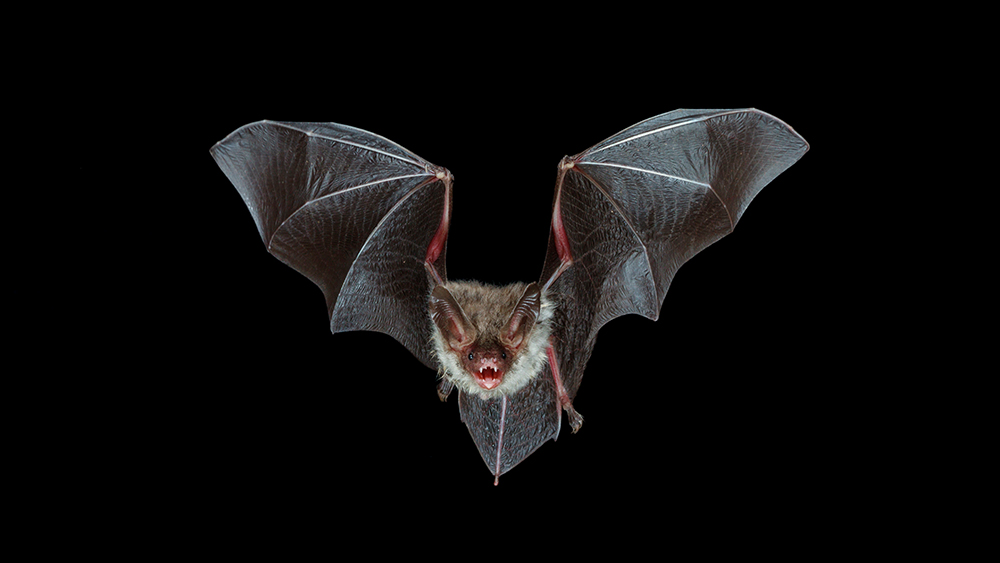Bats have the amazing ability to accurately and consistently detect the speed of sound.1 This enables them to employ a complex system of echolocation in the dark of night to find food in mid-flight and to avoid slamming into trees. But unlike processes in many animals that use a system of learning such as birds singing or lions hunting, bats seem to be hard-wired in their ability to echolocate from birth. Research has now shown that this ability is based on an innate system of speed-of-sound detection.2
Every organism must reliably and accurately sense its environment to survive and reproduce. These complex sensory systems involve features that are innate and unalterable, or hard-wired, and enable immediate function of the overall process. Other aspects of creatures contain a learning component that allows for more flexible adaptation similar to how man-made machine learning algorithms function to develop and fine tune behavior.
As Bats fly around at night, they emit high-pitched signals that reflect off distant objects. The echoes from these are then translated by the bat’s echolocation system based on the time it takes the echo to return, giving an accurate measure of distance. Depending on air conditions (e.g. temperature, humidity), sound waves can move faster or slower and the bat is able to adjust and accommodate for this within a specified range.
To study the nature of this system, researchers at Tel Aviv University in Israel trained eight adult bats to fly to a perch within a dark chamber pumped full of abnormally high levels of oxygen and helium. Because helium is less dense than other gases in the atmosphere, sound waves can travel much faster through it. The researchers discovered that the helium-rich air interfered with the timing of the echolocation, which caused the bats to fall short of landing on the perch. While this was to be expected at the start of the study, the bats never learned to adjust.
The researchers were shocked, thinking the bats would be able to eventually adjust their behavior. The scientists then raised 11 bats from birth, and when they were mature enough to fly, they repeated the study. Despite the helium-rich environment that the bat pups were subjected to, none of them could accurately sense the distance to the perch when high levels of helium were present.
First, these experiments showed that the environment had no magical selective power over the bats to evolve them to adjust their systems to unnatural helium levels. But most importantly, the experiments did reveal that the bats had an innate reference for the speed of sound under natural atmospheric conditions that could at the same time allow them to adjust for reasonable differences in temperature and humidity. In other words, the findings ultimately pointed to the handiwork of an omnipotent Engineer (God the Creator), in which bats have a specific design plan constructed to solve a specific set of challenges.
References
1. Tomkins, J.P. 2019. Complex Creature Engineering Requires a Creator. Acts & Facts. 48 (8).
2. Amichai, E. and Y. Yovel. 2021. Echolocating bats rely on an innate speed-of-sound reference. Proceedings National Academy of Sciences USA. 118 (19): e2024352118.
*Dr. Tomkins is Director of Research at the Institute for Creation Research and earned his doctorate in genetics from Clemson University.

Innate Speed-of-Sound Engineering Revealed in Bats
The Latest
Moroccan Dinosaurs in Marine Rocks, Too
Two recent papers by paleontologist Nicholas Longrich and his colleagues describe some unexpected findings in phosphate mines of northern Morocco.1,2...
CREATION PODCAST
Ernst Haeckel: Evolutionary Huckster | The Creation Podcast:...
Ernst Haeckel, a German Zoologist, is famous for developing a series of images of embryos in development called Anthropogenie. These images,...
Bees Master Complex Tasks Through Social Interaction
Bees are simply incredible.1,2 These little furry fliers challenge the very foundation of Darwinism in many diverse ways.
Bees have been...
The Tail of Man’s Supposed Ancestors
Although it has been known for decades and despite insistence to the contrary from the evolutionary community, man—Homo sapiens—has never...
When Day Meets Night—A Total Success!
The skies cleared above North Texas on Monday, April 8, for a spectacular view of the 2024 Great American Solar Eclipse. Hundreds of guests joined...
The Sun and Moon—Designed for Eclipses
Before discovering thousands of planets in other solar systems, scientists tended to assume that other solar systems would be very similar to our own....
Let ICR Help You Prepare for the Great American Solar Eclipse!
On Monday, April 8th, the moon will move directly between the earth and the sun, resulting in a total solar eclipse visible in northern Mexico, much...
Total Eclipse on April 8th
“You alone are the LORD; You have made heaven, the heaven of heavens, with all their host, the earth and everything on it, the seas and all that...
CREATION PODCAST
Dismantling Evolution One Gear At A Time! | The Creation Podcast:...
The human body is a marvel of complexity and the more we learn about it, the more miraculous our existence becomes! Can evolution explain the...
April 2024 ICR Wallpaper
"He appointed the moon for seasons; The sun knows its going down." (Psalm 104:19 NKJV)
ICR April 2024 wallpaper is now available...































